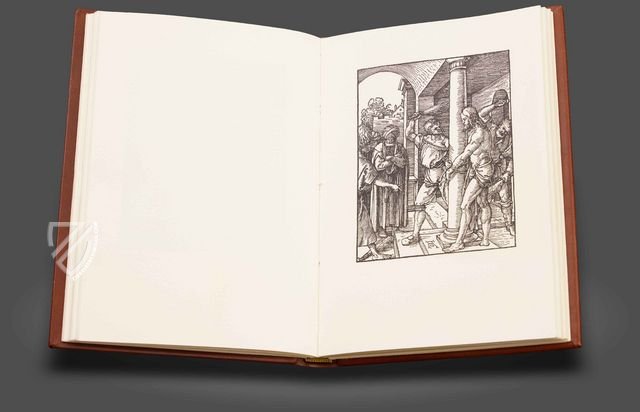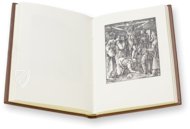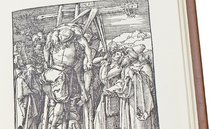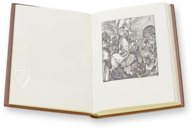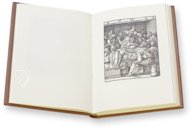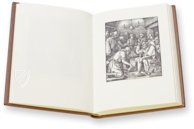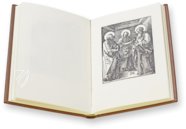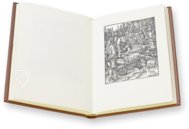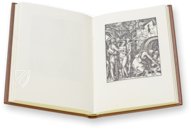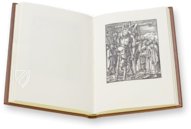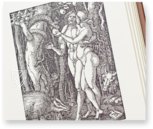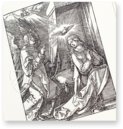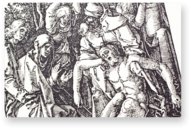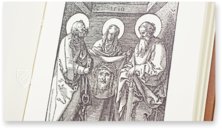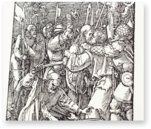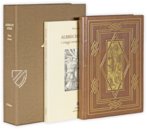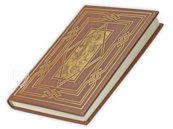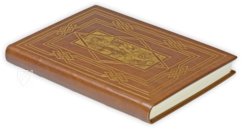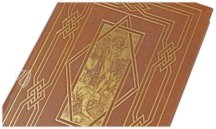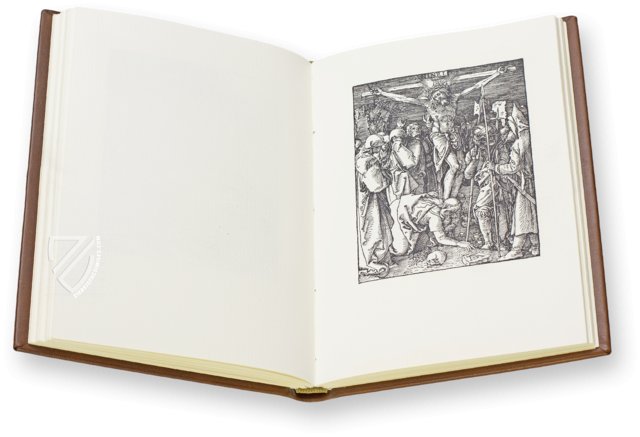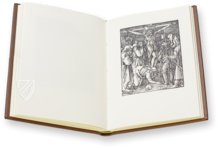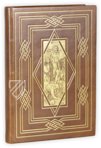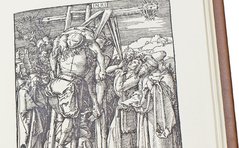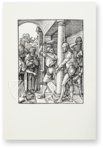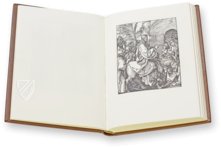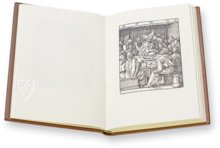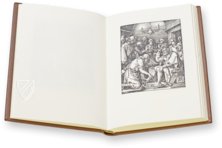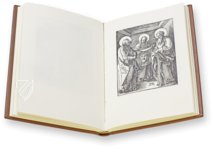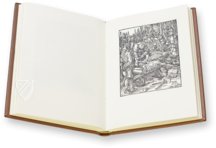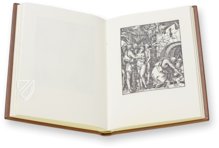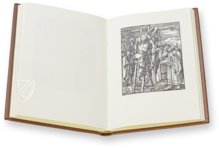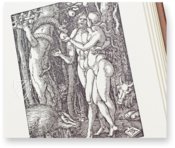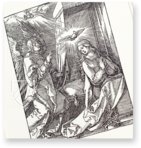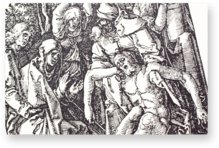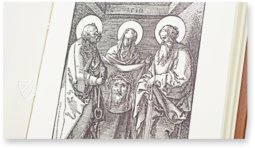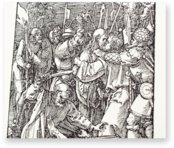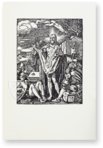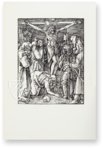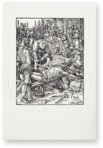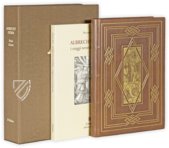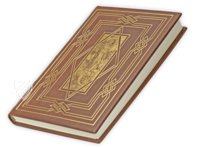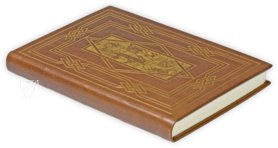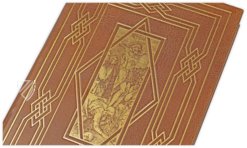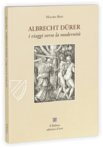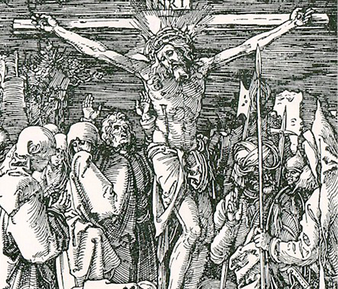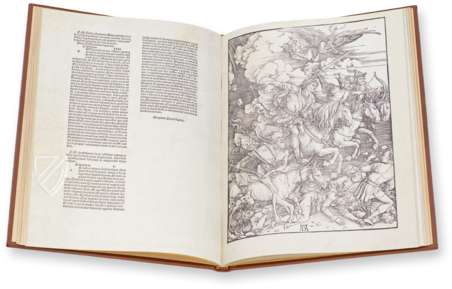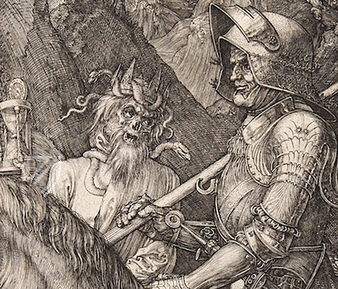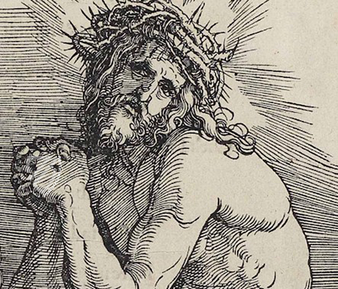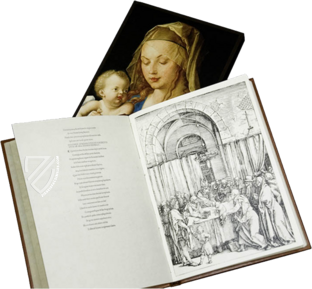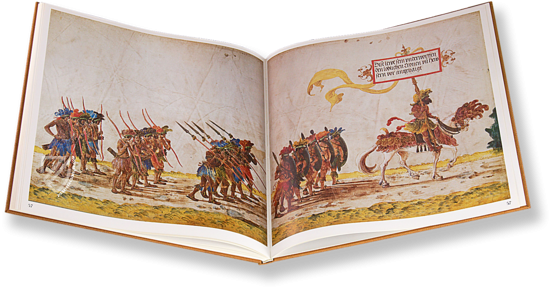Albrecht Dürer - Small Xilographic Passion - Nuremberg, 1511
(1,000€ - 3,000€)
Aside from being a brilliant artist, Albrecht Dürer was also a shrewd businessman who recognized that he could make more money from his woodcuts, which could be published for a wide audience, than from commissions of individual paintings. One of his greatest commercial successes was the so-called Small Passion, which was published in 1511 by Hieronymous Höltzel in Nuremberg. The codex consists of 36 masterful woodcuts and a title page without any text. The popularity of Dürer’s work required the printing of numerous editions and speaks to the religious significance of the Passion in the Late Middle Ages and its subsequent popularity as an artistic subject.
Albrecht Dürer - Small Xilographic Passion - Nuremberg, 1511
This impressive work dedicated to the Passion of the Christ originated from the greatest artist of the German Renaissance. In 1511, Albrecht Dürer published his woodcut series of the so-called Small Passion as a book, which was published by Hieronymous Höltzel in Nuremberg. With his Passion, Albrecht Dürer created a brilliant attestation to the religiosity associated with the Passion in the Late Middle Ages and a significant work of art history, which has not forfeited any of its fascination to this day.
The Greatest Artist of the German Renaissance
Albrecht Dürer was undertaking a grand tour of Italy from 1505 to 1507 and gathered formative impressions for his own art in the Promised Land of the Renaissance. Once returned from Italy, he busied himself with religious subjects such as the life of Mary, the Passion of the Christ, and the Apocalypse. Finally in 1511, Dürer published four series of religious woodcuts in book form, the famous Small Passion among them. The book has 36 full-page woodcuts concerning the theme of the Passion of the Christ, as the title already indicates.
A True Bestseller
This is consistent with a period in the Late Middle Ages when religiosity associated with the Passion was widespread and the Passion was also a popular artistic theme. In private devotion and prayer with the striking images directly before their eyes, the faithful were intended to immerse themselves in the so-called “compassio” and empathize with Christ’s suffering directly. Dürer’s Small Passion became a true bestseller largely due to the theme’s great popularity and was continuously reprinted into the 20th century.
The Passion of the Christ in Brilliant Imagery
36 woodcuts and a title page give the beholder an understanding of the Passion story. Albrecht Dürer, who was already recognized by his contemporaries as a highly-talented graphic artist, particularly for his 1498 woodcut series on the Apocalypse, followed the traditional iconography, and yet conveyed his own unmistakable and perfected style. The series begins with the Fall of Man and the Expulsion from Paradise. After that comes the actual Passion through the death of Christ, the Resurrection, and the Ascension. Dürer additionally inserts some scenes from Genesis and the childhood of Christ into his series. The scene of Judgement Day serves as the last page of the series.
A Modern Book ca. 1500
The woodcuts (also called xylography) with the visual representations are always printed on the right page of the book. The woodcuts of the Small Passion measure 127 x 98 mm (in comparison to the Great Passion measuring 400 x 300 mm). The great popularity of the work would lead to their being reprinted in Venice with Italian text in 1612.
Codicology
- Alternative Titles
- Albrecht Dürer - La Piccola Passione xilografica - Norimberga, 1511
Albrecht Dürer - Kleine xylographische Passion - Nürnberg, 1511 - Size / Format
- 84 pages / 21.0 × 15.0 cm
- Origin
- Germany
- Date
- 1511
- Epochs
- Style
- Genre
- Language
- Illustrations
- 37 masterly full-page woodcuts on the Passion of Christ
- Artist / School
- Albrecht Dürer (1471–1528)
Albrecht Dürer - Small Xilographic Passion - Nuremberg, 1511
The Resurrection
Still dressed in a burial robe and holding a staff with a cross and banner blowing dramatically in the wind, Christ is shown emerging in splendor from his tomb after three days. On the right, a guard armed with a halberd tries to shield his eyes from the sunburst appearing behind Christ’s head, while on the left, the Three Marys are shown in the distance bathed in sunlight as they make their way to the tomb. The densely designed image uses overlapping forms and stark contrast.
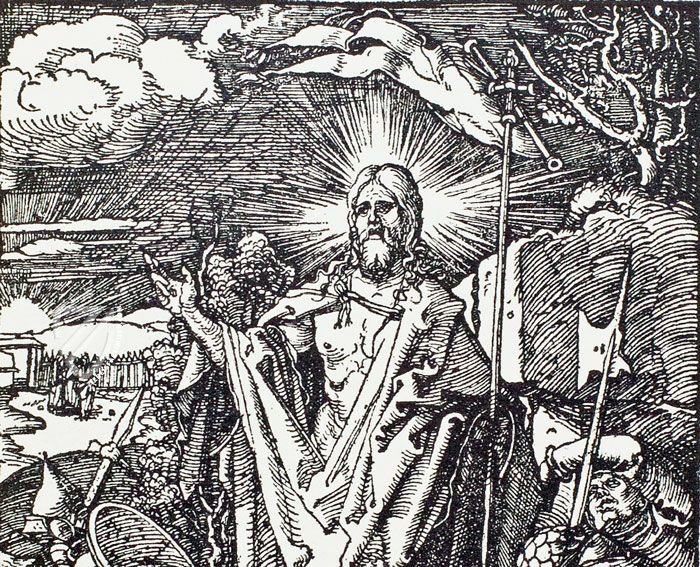
Albrecht Dürer - Small Xilographic Passion - Nuremberg, 1511
The Flagellation
One of the most iconic scenes of the Passion is presented here in a combination of masterful architecture and grim faces. Christ stands tied to a column stripped to the waist as two soldiers flog him, stripped of their armor to free their movements, while richly dressed Pharisees smugly look on with crossed arms.
Christ is calm and composed, portrayed in profile, but his floggers’ faces are grotesque, even demonic, with dark eyes. The perfection of the architectural perspective contrasts sharply with the disheveled appearance of Christ’s oppressors. A third soldier, portrayed in profile with ape-like facial features, points to Dürer’s iconic “AD” monogram engraved at Christ’s feat, implying the guilt of the artist and all sinners in the suffering of the Redeemer.
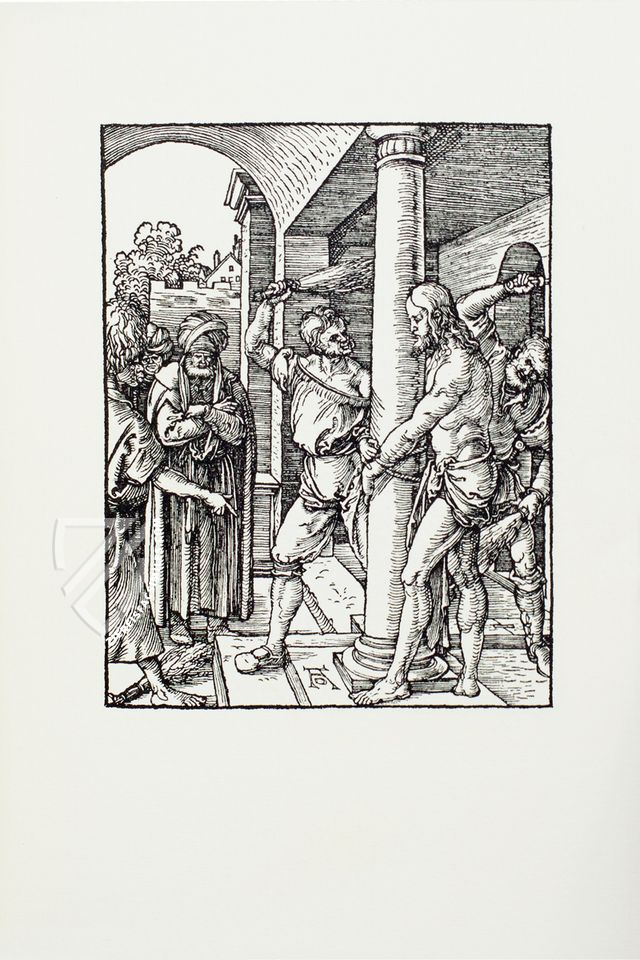
#1 Albrecht Dürer - La Piccola Passione xilografica - Norimberga 1511
Language: Italian
(1,000€ - 3,000€)
- Treatises / Secular Books
- Apocalypses / Beatus
- Astronomy / Astrology
- Bestiaries
- Bibles / Gospels
- Chronicles / History / Law
- Geography / Maps
- Saints' Lives
- Islam / Oriental
- Judaism / Hebrew
- Single Leaf Collections
- Leonardo da Vinci
- Literature / Poetry
- Liturgical Manuscripts
- Medicine / Botany / Alchemy
- Music
- Mythology / Prophecies
- Psalters
- Other Religious Books
- Games / Hunting
- Private Devotion Books
- Other Genres
- Afghanistan
- Armenia
- Austria
- Belgium
- Belize
- Bosnia and Herzegovina
- China
- Colombia
- Costa Rica
- Croatia
- Cyprus
- Czech Republic
- Denmark
- Egypt
- El Salvador
- Ethiopia
- France
- Germany
- Greece
- Guatemala
- Honduras
- Hungary
- India
- Iran
- Iraq
- Israel
- Italy
- Japan
- Jordan
- Kazakhstan
- Kyrgyzstan
- Lebanon
- Liechtenstein
- Luxembourg
- Mexico
- Morocco
- Netherlands
- Palestine
- Panama
- Peru
- Poland
- Portugal
- Romania
- Russia
- Serbia
- Spain
- Sri Lanka
- Sweden
- Switzerland
- Syria
- Tajikistan
- Turkey
- Turkmenistan
- Ukraine
- United Kingdom
- United States
- Uzbekistan
- Vatican City
- A. Oosthoek, van Holkema & Warendorf
- Aboca Museum
- Ajuntament de Valencia
- Akademie Verlag
- Akademische Druck- u. Verlagsanstalt (ADEVA)
- Aldo Ausilio Editore - Bottega d’Erasmo
- Alecto Historical Editions
- Alkuin Verlag
- Almqvist & Wiksell
- Amilcare Pizzi
- Andreas & Andreas Verlagsbuchhandlung
- Archa 90
- Archiv Verlag
- Archivi Edizioni
- Arnold Verlag
- ARS
- Ars Magna
- ArtCodex
- AyN Ediciones
- Azimuth Editions
- Badenia Verlag
- Bärenreiter-Verlag
- Belser Verlag
- Belser Verlag / WK Wertkontor
- Benziger Verlag
- Bernardinum Wydawnictwo
- BiblioGemma
- Biblioteca Apostolica Vaticana (Vaticanstadt, Vaticanstadt)
- Bibliotheca Palatina Faksimile Verlag
- Bibliotheca Rara
- Boydell & Brewer
- Bramante Edizioni
- Bredius Genootschap
- Brepols Publishers
- British Library
- C. Weckesser
- Caixa Catalunya
- Canesi
- CAPSA, Ars Scriptoria
- Caratzas Brothers, Publishers
- Carus Verlag
- Casamassima Libri
- Centrum Cartographie Verlag GmbH
- Chavane Verlag
- Christian Brandstätter Verlag
- Circulo Cientifico
- Club Bibliófilo Versol
- Club du Livre
- CM Editores
- Collegium Graphicum
- Collezione Apocrifa Da Vinci
- Comissão Nacional para as Comemorações dos Descobrimentos Portugueses
- Coron Verlag
- Corvina
- CTHS
- D. S. Brewer
- Damon
- De Agostini/UTET
- De Nederlandsche Boekhandel
- De Schutter
- Deuschle & Stemmle
- Deutscher Verlag für Kunstwissenschaft
- DIAMM
- Droz
- E. Schreiber Graphische Kunstanstalten
- Ediciones Boreal
- Ediciones Grial
- Ediclube
- Edições Inapa
- Edilan
- Editalia
- Edition Deuschle
- Edition Georg Popp
- Edition Leipzig
- Edition Libri Illustri
- Editiones Reales Sitios S. L.
- Éditions de l'Oiseau Lyre
- Editions Medicina Rara
- Editorial Casariego
- Editorial Mintzoa
- Editrice Antenore
- Editrice Velar
- Edizioni Edison
- Egeria, S.L.
- Eikon Editores
- Electa
- Emery Walker Limited
- Enciclopèdia Catalana
- Eos-Verlag
- Ephesus Publishing
- Ernst Battenberg
- Eugrammia Press
- Extraordinary Editions
- Fackelverlag
- Facsimila Art & Edition
- Facsimile Editions Ltd.
- Facsimilia Art & Edition Ebert KG
- Faksimile Verlag
- Feuermann Verlag
- Folger Shakespeare Library
- Franco Cosimo Panini Editore
- Friedrich Wittig Verlag
- Fundación Hullera Vasco-Leonesa
- G. Braziller
- Gabriele Mazzotta Editore
- Gebr. Mann Verlag
- Gesellschaft für graphische Industrie
- Getty Research Institute
- Giovanni Domenico de Rossi
- Giunti Editore
- Graffiti
- Grafica European Center of Fine Arts
- Guido Pressler
- Guillermo Blazquez
- Gustav Kiepenheuer
- H. N. Abrams
- Harrassowitz
- Harvard University Press
- Helikon
- Hendrickson Publishers
- Henning Oppermann
- Herder Verlag
- Hes & De Graaf Publishers
- Hoepli
- Holbein-Verlag
- Houghton Library
- Hugo Schmidt Verlag
- Idion Verlag
- Il Bulino, edizioni d'arte
- ILte
- Imago
- Insel Verlag
- Insel-Verlag Anton Kippenberger
- Instituto de Estudios Altoaragoneses
- Instituto Nacional de Antropología e Historia
- Introligatornia Budnik Jerzy
- Istituto dell'Enciclopedia Italiana - Treccani
- Istituto Ellenico di Studi Bizantini e Postbizantini
- Istituto Geografico De Agostini
- Istituto Poligrafico e Zecca dello Stato
- Italarte Art Establishments
- Jan Thorbecke Verlag
- Johnson Reprint Corporation
- Josef Stocker
- Josef Stocker-Schmid
- Jugoslavija
- Karl W. Hiersemann
- Kasper Straube
- Kaydeda Ediciones
- Kindler Verlag / Coron Verlag
- Kodansha International Ltd.
- Konrad Kölbl Verlag
- Kurt Wolff Verlag
- La Liberia dello Stato
- La Linea Editrice
- La Meta Editore
- Lambert Schneider
- Landeskreditbank Baden-Württemberg
- Leo S. Olschki
- Les Incunables
- Liber Artis
- Library of Congress
- Libreria Musicale Italiana
- Lichtdruck
- Lito Immagine Editore
- Lumen Artis
- Lund Humphries
- M. Moleiro Editor
- Maison des Sciences de l'homme et de la société de Poitiers
- Manuscriptum
- Martinus Nijhoff
- Maruzen-Yushodo Co. Ltd.
- MASA
- Massada Publishers
- McGraw-Hill
- Metropolitan Museum of Art
- Militos
- Millennium Liber
- Müller & Schindler
- Nahar - Stavit
- Nahar and Steimatzky
- National Library of Wales
- Neri Pozza
- Nova Charta
- Oceanum Verlag
- Odeon
- Orbis Mediaevalis
- Orbis Pictus
- Österreichische Staatsdruckerei
- Oxford University Press
- Pageant Books
- Parzellers Buchverlag
- Patrimonio Ediciones
- Pattloch Verlag
- PIAF
- Pieper Verlag
- Plon-Nourrit et cie
- Poligrafiche Bolis
- Presses Universitaires de Strasbourg
- Prestel Verlag
- Princeton University Press
- Prisma Verlag
- Priuli & Verlucca, editori
- Pro Sport Verlag
- Propyläen Verlag
- Pytheas Books
- Quaternio Verlag Luzern
- Reales Sitios
- Recht-Verlag
- Reichert Verlag
- Reichsdruckerei
- Reprint Verlag
- Riehn & Reusch
- Roberto Vattori Editore
- Rosenkilde and Bagger
- Roxburghe Club
- Salerno Editrice
- Saltellus Press
- Sandoz
- Sarajevo Svjetlost
- Schöck ArtPrint Kft.
- Schulsinger Brothers
- Scolar Press
- Scrinium
- Scripta Maneant
- Scriptorium
- Shazar
- Siloé, arte y bibliofilia
- SISMEL - Edizioni del Galluzzo
- Sociedad Mexicana de Antropología
- Société des Bibliophiles & Iconophiles de Belgique
- Soncin Publishing
- Sorli Ediciones
- Stainer and Bell
- Studer
- Styria Verlag
- Sumptibus Pragopress
- Szegedi Tudomànyegyetem
- Taberna Libraria
- Tarshish Books
- Taschen
- Tempus Libri
- Testimonio Compañía Editorial
- Thames and Hudson
- The Clear Vue Publishing Partnership Limited
- The Facsimile Codex
- The Folio Society
- The Marquess of Normanby
- The Richard III and Yorkist History Trust
- Tip.Le.Co
- TouchArt
- TREC Publishing House
- TRI Publishing Co.
- Trident Editore
- Tuliba Collection
- Typis Regiae Officinae Polygraphicae
- Union Verlag Berlin
- Universidad de Granada
- University of California Press
- University of Chicago Press
- Urs Graf
- Vallecchi
- Van Wijnen
- VCH, Acta Humaniora
- VDI Verlag
- VEB Deutscher Verlag für Musik
- Verlag Anton Pustet / Andreas Verlag
- Verlag Bibliophile Drucke Josef Stocker
- Verlag der Münchner Drucke
- Verlag für Regionalgeschichte
- Verlag Styria
- Vicent Garcia Editores
- W. Turnowski Ltd.
- W. Turnowsky
- Waanders Printers
- Wiener Mechitharisten-Congregation (Wien, Österreich)
- Wissenschaftliche Buchgesellschaft
- Wissenschaftliche Verlagsgesellschaft
- Wydawnictwo Dolnoslaskie
- Xuntanza Editorial
- Zakład Narodowy
- Zollikofer AG

